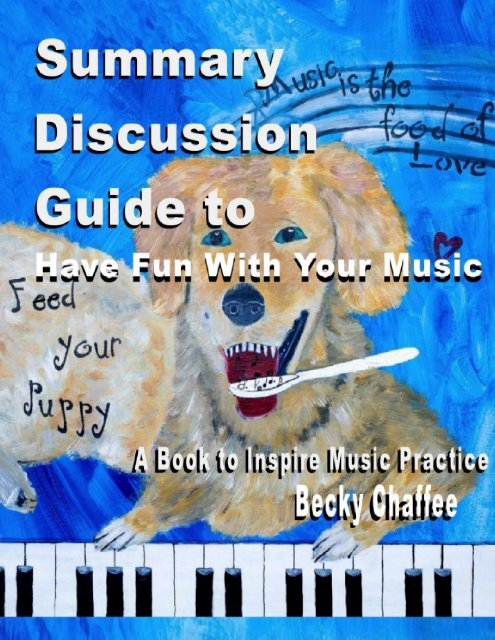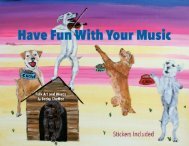discussion booklet for HaveFunwithYourMusic
You also want an ePaper? Increase the reach of your titles
YUMPU automatically turns print PDFs into web optimized ePapers that Google loves.
A Summary Discussion Guide to<br />
Have Fun With Your Music<br />
A Book to Inspire Music Practice<br />
Written by Becky Chaffee<br />
Cover Art by Becky Chaffee<br />
Copyright © October 2020 Becky Chaffee
1.0 Title Page and Introduction<br />
(Suggested Discussion)<br />
T<br />
he Title Page and first pages of the book, Have Fun With Your Music by Becky Chaffee,<br />
introduce the idea that music is fun. Kids, parents and anyone practicing an instrument<br />
easily lose sight of the fact that playing a musical instrument is a great privilege and<br />
should be approached as a fun thing to do.<br />
Practicing can seem like a monotonous chore since one needs to practice regularly, preferably<br />
every day. Find a way to have the attitude of fun by choice, empowering the child or yourself. Perhaps<br />
record yourself, listen to other musicians on-line play the same music that you are learning, or play <strong>for</strong><br />
your pets or stuffed animals to get inspiration.<br />
The Title Page and first page introduce several unusual instruments, the lowest, a bass, a tuba,<br />
a contrabass flute and the highest, the flute, violin and piccolo; and one of the widest ranging<br />
instruments, a keyboard.<br />
Just <strong>for</strong> fun, you can talk about what is funny or unusual in each picture.<br />
Do you know the difference between a fiddle and a violin? The main difference is the style of music<br />
played. A violin can be used as a fiddle, but if one were specifically a fiddler, your bridge might be a<br />
slightly different shape. In addition, a fiddler might have a different string choice and hold both the<br />
violin and the bow in a different manner to play.
2.0 Motivation <strong>for</strong> Practice<br />
W<br />
hat do you think is the hardest part of practicing?<br />
I have found that the hardest part is getting started. Like the famous marathon<br />
runner, Katherine Switzer, is quoted saying that the hardest part of running is<br />
getting your shoes on.<br />
When my children were young, and I knew they didn’t feel like doing their daily practice sometimes I<br />
would say, “Just play <strong>for</strong> 10 minutes, I’ll put the kitchen timer on”. (Note that I didn’t say that I would<br />
put the timer on <strong>for</strong> 10 minutes.) I put the timer on <strong>for</strong> their normal practice time, whether 30 or 45<br />
minutes. They never stopped short of their practice time or after just 10 minutes. The reason why is<br />
because once you start, it is fun, engaging and challenging. I am an amateur musician that plays <strong>for</strong> fun,<br />
but occasionally I play <strong>for</strong> my music club or an event. I even do this to myself! When I need to be<br />
practicing, but think I don’t have time <strong>for</strong> a proper practice, I tell myself just do 10 minutes to get myself<br />
to sit down. I always practice much longer once I start.<br />
It is hard having to practice every day if you think of practicing as a chore like brushing your teeth. What<br />
can you do <strong>for</strong> yourself <strong>for</strong> motivation? Attitude makes everything different and can be a huge<br />
difference in the amount of fun, interest and energy you pour into an activity. For kids to come up with<br />
their own ideas of what would make practicing something to look <strong>for</strong>ward to is empowering. It can be<br />
anything and it can change with age. Preparing to play with a group, preparing to play <strong>for</strong> a party, <strong>for</strong><br />
friends, playing <strong>for</strong> your pet or stuffed animals? Playing the music that you love most? Making it into a<br />
game with goals or even points?
3.0 Warm Up <strong>for</strong> Practice<br />
W<br />
arming up can seem silly when you can just play. Why not warm up while playing<br />
your piece? It may be easier to understand warming up <strong>for</strong> sports. Warming up<br />
stretches your muscles so they won't be hurt. But playing scales and exercises <strong>for</strong><br />
the instrument to warm up is about so much more.<br />
First of all, which muscles do you use when you play your instrument? When I started taking<br />
lessons and worked on more advanced pieces that had my fingers moving a lot faster, I started<br />
having problems with my wrists. A lot of people recommend finger stretching exercises or doing<br />
yoga <strong>for</strong> instrumentalists. So at least warming up on your instrument with scales and related<br />
exercises including long tones <strong>for</strong> winds and brass is important.<br />
I spent a year playing exercises just to strengthen my ring and pinky fingers on both hands. They<br />
seem to be naturally weaker, and at least on the flute are used less than other fingers. Exercises<br />
like scales strengthen all of your fingers. In other words, they don’t miss strengthening your<br />
weaker fingers, as playing certain styles of music might.<br />
You also need to learn scale patterns to be a better sight reader in the future. You will recognize<br />
scale patterns and be able to read music better if you already recognize the patterns, and also<br />
can already play them! If you need to memorize music <strong>for</strong> per<strong>for</strong>mances, it will make these<br />
recognizable note patterns or passages easier to memorize.
4.0 Practice Slowly<br />
I<br />
hear complaints all the time from my teacher friends that students that say, “students<br />
want to play through the whole piece really quickly”. However, when you just learn a new<br />
piece, you need to go through it slowly so that you get each note and the counting of each<br />
note correct the first few times playing the piece. If you play the wrong note even once,<br />
your brain registers the wrong note, and it becomes harder to correct. When you play a wrong<br />
note, you are teaching your brain to play the note incorrectly. It’s all about teaching your brain.<br />
I must say, when I start working on a new fast piece, I can’t wait to be able to play the notes<br />
quickly. I myself, have trouble playing slowly until I learn the notes correctly. So, I know that<br />
this can be hard to do. If you make this a habit, the habit will stay with you to practice correctly.<br />
I think a valuable video that explains this is from Dr. Molly Gebrian, violist and educator with a<br />
background in neuroscience. Use this link to see this eye-opening explanation:<br />
https://bit.ly/33Phyas
5.0 Practice Backwards<br />
P<br />
racticing slowly is one technique to use where the goal is to learn a difficult passage.<br />
But sometimes, it is still hard to play a difficult passage. Another way to get your<br />
fingers or perhaps mouth or tongue to play a difficult passage is to isolate just two<br />
notes in that passage – say the last two notes of the passage. Can you play just two<br />
notes correctly? Now add a third note, the note be<strong>for</strong>e the last two notes. So now can you play<br />
those three notes? Keep playing just the three notes until you can play them. Keep adding a<br />
note until you have the passage learned.
6.0 Keep Your Instrument in Tune<br />
S<br />
ome instruments are harder to keep in tune than others. For a piano, you need to call a<br />
professional tuner to tune it. Instruments can get out of tune while playing if you are<br />
playing in very hot or cold rooms or if playing outdoors. Violin strings need to be<br />
attended to <strong>for</strong> intonation corrections while playing. Wind and brass instruments often<br />
have certain notes that are hard to play in tune. You need to learn which notes on your<br />
instrument are harder to play in tune, and how to adjust your fingers or mouth/airstream to<br />
make sure they are in tune. You can occasionally play scales and music while watching a tuner to learn<br />
which notes you have trouble with on your instrument and figure out how to make adjustments. It is<br />
also worthwhile to practice tuning your instrument to a (tuned) piano, then compare all your notes<br />
by playing scales or other music along with a pianist.
7.0 Sleep On It<br />
S<br />
cientists who have studied the physiology of sleep have determined that, if you<br />
practice a musical passage late at night, and then take your night’s sleep soon<br />
afterwards, this interval of sleeping that occurs right after practicing will improve your<br />
memory of the passage. The reason is because your brain goes over and over what you<br />
practiced while you sleep making neural connections in the brain to store it in your memory. If<br />
you experiment with this on your own, you will find it to be magic.<br />
Getting a full 8 hour night of sleep is more important and effective than reviewing and<br />
cramming in<strong>for</strong>mation into your brain all night without getting enough sleep. This applies to<br />
learning or memorizing any kind of in<strong>for</strong>mation. I wish I had known this in college when I stayed<br />
up all night be<strong>for</strong>e tests.<br />
If you have more interest in this topic, explore Dr. Molly Gebrian's website again, and also read<br />
"Why We Sleep" by Matthew Walker.
8.0 Express Yourself<br />
I<br />
f you use your music to express your feelings, it will become a great emotional outlet <strong>for</strong> you. In<br />
addition, your music will sound better. Also think of what the composer wanted to express when he<br />
or she wrote the music. Can you express the feelings of your piece?<br />
You can look up in<strong>for</strong>mation about the composer and about the piece you are learning to find out what<br />
it is meant to express. In addition, you can write your own story to go with the music you are learning,<br />
then think of making that picture when you play. Adding your own interpretations, when playing a<br />
musical composition, can increase the enjoyment of playing the piece.<br />
Do you know what your favorite kind of music is? Perhaps you can add one of your own favorite songs<br />
to your repertoire. (Generally teachers have you learn specific music pieces so that they can teach you<br />
new techniques or concepts in an appropriate order).<br />
Arrange to play <strong>for</strong> your family and friends regularly to show them the joy in your music. You can even<br />
play <strong>for</strong> your pets or stuffed animals!! Just make sure you are having fun with it!
9.0 Stop If You Play A Wrong Note<br />
S<br />
top immediately if you play a note wrong!!! This goes with practice slowly, and don't<br />
learn wrong notes. As I said be<strong>for</strong>e, it's all about teaching the brain. If you play a wrong<br />
note, your brain will learn it wrong, and it will be harder and harder to correct.<br />
If you have played a wrong note, stop playing the piece, and play the passage a few times using<br />
the correct note, then proceed and resume playing the rest of the piece. Play the phrase at the<br />
very least three times in a row correctly be<strong>for</strong>e you continue playing. That is the very least -<br />
maybe 5 times or even 10 times in a row correctly. If you make a mistake playing while playing<br />
it 3 to 10 times in a row correctly, you should start over from the count of one time correctly.
10.0 Practice With A Metronome<br />
S<br />
ome teachers are sticklers about always practicing a piece with a metronome, and some<br />
teachers think that if you rely excessively on a metronome, you won't learn to be<br />
musical. However, using the metronome as a tool to play with your scales and music<br />
that you are learning will help you improve gradually. Don't turn the metronome up too high at<br />
first because a metronome that is too fast will increase the risk of making mistakes when you<br />
practice on your musical instrument. Also, don't turn the metronome speed up too fast so that<br />
you want to give up. You can set goals <strong>for</strong> improving your speed by ten beats per minute over<br />
the period of a week.
11.0 Play With Dynamics<br />
M<br />
usicians can express their creative instinct and musical individuality by playing<br />
notes loudly and softly, using crescendos and decrescendos, and playing single<br />
notes with accents. Music students often <strong>for</strong>get to use dynamics.<br />
There are a lot of other things you can do combined with dynamics to express a mood with your<br />
music. For example, you can make your music more expressive with your “breathing”. (You<br />
don’t actually take breaths when playing stringed instruments, but you still need to include<br />
breath-like pauses). If you sing a phrase, it will help you find the natural place where a breath<br />
should be. With experience, you will learn how to do this. It can even be hard to decide where<br />
to take a breath when you are playing a wind or brass instrument.<br />
You can play notes with different styles, which help you give the piece a specific feeling. You<br />
can play “lightly” or harshly. You can play staccato note or legato note styles. Can you think of<br />
more techniques?
12.0 Practice Like It’s A Per<strong>for</strong>mance<br />
T<br />
here are so many things to concentrate on when playing. If you are in the habit of<br />
practicing with good tone, intonation, dynamics, then there will be less to worry about<br />
during a real per<strong>for</strong>mance. So what can you do with every practice to make sure you are<br />
practicing with the best playing you can manage? Be<strong>for</strong>e I knew how to warm up properly, I<br />
sometimes would practice with bad tone because my muscles wouldn't always work without a<br />
warm-up.
13.0 Record Yourself<br />
W<br />
hen you record yourself you can be your own teacher. You can listen to yourself<br />
better and hear little nuances in your playing such as uneven notes, that you might<br />
not notice when you are concentrating on playing the notes. You can listen to what<br />
needs correcting. If you use a computer video, you can see your posture or presentation.<br />
One teacher told me that when she turns on a video recorder in the lesson, a student that<br />
usually groans about having to play a piece over <strong>for</strong> her wants to play it over and over and over.<br />
When I video myself, it works that way too. I keep wanting another chance to get it better. So I<br />
play it again and again.<br />
One more benefit of recording yourself is that it is like a dress rehearsal <strong>for</strong> preparing to play in front of<br />
people. Sometimes, I actually feel nervous if I get dressed up, then play in front of a recorder.
14.0 Ear Training<br />
L<br />
isten to lots of music. Listen to recordings of the music you are learning. Perhaps you can listen to<br />
it played by different musicians to see if you can hear the differences in how they play the same<br />
music.<br />
Another idea to train your ear is to listen to your favorite music. Any kind of music is fine. Try to play<br />
along with a recording of your favorite music without sheet music. Pick out the notes by ear. It is hard at<br />
first, but gets easier if you keep at it. You can also try to play harmony or make up an accompaniment to<br />
the music. Being able to play without sheet music is a fun skill to have.
15.0 Have Fun With It!<br />
T<br />
he rest of the book is encouragement to practice and have fun playing. Attitude is everything.<br />
Set your own short-term and long-term goals <strong>for</strong> practicing. It will be empowering if you take<br />
charge of your own practicing. You will feel more accomplished.<br />
It is very helpful <strong>for</strong> a self-published author if you leave a review on Amazon. If<br />
you appreciate this companion book, the author would be grateful if you paid her<br />
with a review <strong>for</strong> this Summary Discussion Guide to Have Fun with Your Music.<br />
www.MusicTeacherGifts.com





